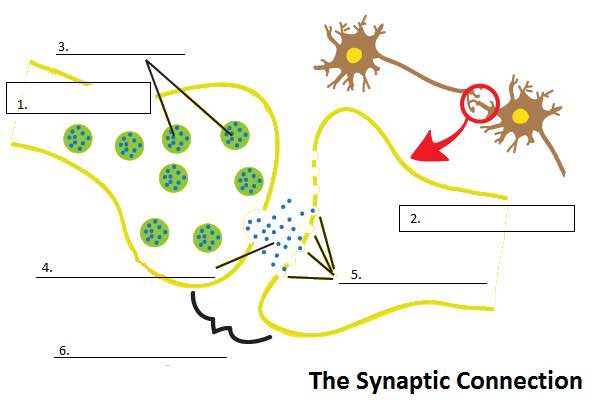Today we returned for a third series of Biology classroom visits at Skyview High…
These weekly visits have allowed us to get to know some students, and build up more understanding of not only what real brains look and feel like, but also how they are made (partly) of current-carrying cells called neurons, which are linked to each other across synaptic gaps, or clefts…
Our teachers in training put together the diagram below:
They explained to students how communication across synapses (Number (6) in the handout, above), from (1) the presynaptic neuron (“pre” indicating the neuron “before” the gap), to (2) the postsynaptic neuron (“post” meaning “after” the gap), occurs chemically, involving the release of a chemical neurotransmitter (4) into the gap, typically after arrival of an electrical current (or action potential) at the presynaptic axon terminal (“terminal” meaning “end” of the axon).
Students could reference their diagram from the previous week to review important components of the neuron…
Drugs, which are themselves chemicals, often act at synapses to disrupt the normal flow of information. Some drugs empty or prevent the transport of neurotransmitters into membrane-bound storage sacks called vesicles (3), or activate or inhibit the reception of chemical information by large, membrane-embedded proteins known as receptors (5)…
Today we began with an art project, to put these many synaptic connections in context, and remind our students of functional neural networks found in different regions of their brains. Jeff Leake introduced everyone to some basic skills involved in working with clay, and how to form an impressive miniature brain…
We had lots of busy classroom activity, early in the morning, with students molding their brains, creating their own unique models, while our undergraduate volunteers from PSU and WSU Vancouver pointed out structure and function relationships in smaller groups…
After building cerebrums, and reviewing lobes, our Noggin volunteers explained the various parts of the many synapses that link neurons together chemically in the brain, including axon terminals, vesicles, receptors, post-synaptic membranes, etc…
Students then participated in a motivated discussion of drugs, including what they are (again, chemicals), where they act (often at receptors, and at other protein “machines” found in our chemical synapses), and how their effects on cognition, behavior, perception and mood relate directly to these actions, and to where in the brain these drug actions occur…
We made use of a wonderful online educational resource from the University of Utah’s Department of Genetics, known as “Mouse Party,” which illustrates many of the actions of alcohol, cannabinoids (the psychoactive chemicals in marijuana), LSD, ecstasy, cocaine, and other drugs…
Our volunteers brought up dopamine (abbreviated as DA), a neurotransmitter released in specific synapses, in specific brain areas, in response to stimuli that predict the arrival of some kind of reward.
(Image from TreAD lab @ Emory University; http://www.psychology.emory.edu/clinical/treadway/lab/Research.html)
Dopamine release results in motivated behaviors, and we discussed how involved it is in healthy motivations, like bettering your job skills to earn money, or improving your ability to play a sport, or an instrument, to gain social reward, opportunity, the pleasure of a performance, the joys of team effort, and good health…
One serious concern with drug use in adolescents is how decision making networks in the rapidly developing frontal lobes will rewire in response to drug-induced dopamine activity, generating an unusually strong and impulsive drive towards stimuli associated with drug seeking, and drug taking, instead of healthier pursuits…
Chronic drug use also changes the structure of critical dopamine synapses, leading to less overall response in dopamine brain networks that are essential for experiencing all motivation, and drive. This can seriously reduce how much motivation you can experience, and make life far less engaging, exciting and fun…
Many thanks to Angela Fojtik, the Biology teacher who has warmly welcomed us to her classroom, and to Hannah Valenti of GEAR UP, the federal grant providing us with sheep brains (for our upcoming fourth and final visit), pipe cleaners and clay!


































